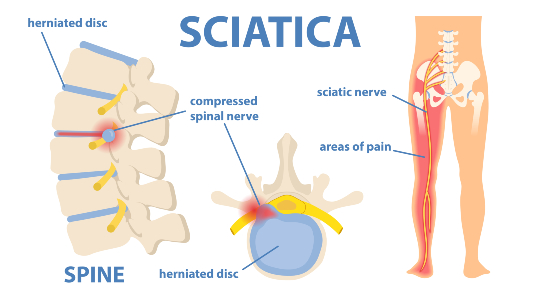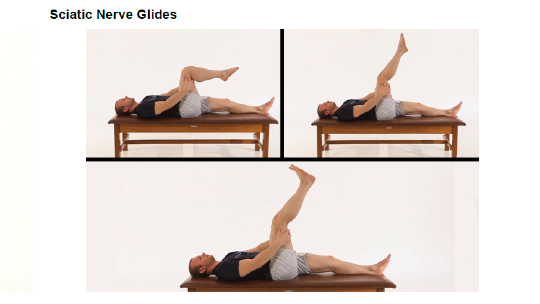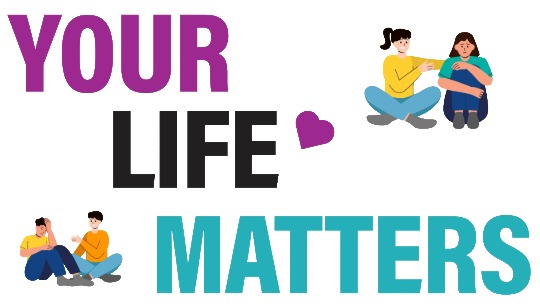It started with mild pain in my lower back. ‘Nothing to worry about, just need to stretch it out,’ I thought to myself. Two weeks later, I was in pain sitting down, standing up, and getting out of bed. Any movement had to be done carefully, and even then, the shooting pain was excruciating. After a visit with my primary care provider (PCP), I had my diagnosis: sciatica.
What is sciatica?
Sciatica is a condition that irritates or compresses the sciatic nerve, which is the largest and longest nerve in your body. It runs from your lower back, into the glutes, and down the back of each leg.

“When the sciatic nerve is irritated or compressed, pain, numbness, or tingling can radiate from your lower back or behind the thigh down to your feet,” explains Michael Lui, M.D., chief of neurology at Pali Momi Medical Center. “These symptoms make simple activities such as walking, sitting, or sleeping more difficult or uncomfortable.”
When I first felt the sciatica pain in my back, it didn’t bother me too much. I thought it was manageable, and it only happened when I bent over to pick something up. But the intensity ramped up quickly, and soon, I could no longer sit without sharp pain that also shot down my left leg and into my toes. My leg also alternated between tingling and numbness, as if it had fallen asleep.
What causes sciatica?
Various conditions can lead to sciatica, including osteoarthritis, pregnancy, or injury. In my case, my PCP says a herniated disk was to blame, likely because I was sitting too long in the same position.
Make sure to consult with your health care provider to help determine the diagnosis and possible cause.
How is sciatica treated?
Some mild cases of sciatica can be treated with self-care measures. Using ice packs, heating pads, or over-the-counter anti-inflammatory medicines can all help reduce pain, swelling, and inflammation. When I explained my level of pain to my PCP, she referred me to physical therapy (PT).
“PT can help you learn how to stretch and exercise properly to reduce pressure on the sciatic nerve,” explains Dr. Lui.
Many of the stretches that help improve sciatica are common yoga poses. My physical therapist also always has me do sciatic nerve glides during our appointments and at home. The goal is to improve the mobility and natural gliding ability of the nerve.

“Nerves aren’t flexible like muscles are, so you want to avoid stretching it as that will cause more irritation to the nerve,” says Jeremy Ueki, who has a doctorate in physical therapy and is co-owner of Rehab Therapy Partners, which has offices in Pearl City and Kaimuki. “So, hold from performing a hamstring stretch and perform sciatic nerve glides instead.”
Because there are so many causes of sciatica, there are also many ways to address and treat the condition. PT is a good starting point to assess your specific case.
“A physical therapist can determine the most optimum strategies and exercises to resolve your pain and symptoms,” says Ueki.
A balancing act
I’ll be honest: I didn’t realize what a long journey I’d have to endure. Mild cases can often be resolved within six weeks, and I was hopeful that would be my situation. Unfortunately, I passed the three-month mark in July, so my sciatica is now considered chronic. While the pain and tingling are near constant, the level of pain is much more tolerable compared to how I felt in April, when the pain was so severe that I didn’t want to leave my bed.
My physical therapist advised that finding the right balance between sitting, standing, and walking can help alleviate symptoms. Sitting is the most painful; I bought a lumbar support pillow to help ease pressure on the sciatic nerve. It’s helped some, but I do need to stand every 20 minutes or so.
Walking has perhaps been the most effective, but since it’s not practical during the workday, I recently purchased a walking pad to get some steps in and avoid sitting. I just need to be careful to not overdo it because that can worsen the pain.

If you have sciatica, finding that balance will take some trial and error. And while the diagnosis may be frustrating, know that it’s not a life sentence. There may be flare-ups but with the proper support, sciatica can be managed.
Time for a check-up
We only have one body, so it’s important to take care of it! Read below for more stories that prioritize health and wellness:
beyond blurry vision
Cataracts are a normal part of aging; as we get older, the natural lens in the eye becomes cloudy, making it harder to see. But there’s hope in cataract surgery. Neda Nikpoor, M.D., ophthalmologist at Jenkins Eye Care, shares what you need to know.
kidney disease: a killer in the shadows
Early detection can prevent the progression of kidney disease, but it often goes undetected until it’s advanced and dialysis or a transplant is needed. Enter Aloha Kidney, a series of classes that teaches you the rules of the body, allowing you to mindfully nudge yourself towards health and away from the chronic disease.
stroke: every second counts
Quick decisive action in the hours right after signs of a stroke is critical to a patient’s long-term recovery. There are a lot of steps to treating a stroke patient in a short amount of time. From the 911 call to arriving at the ER, here’s what to expect.
understanding diabetes
Diabetes may be a chronic disease, but all three forms of it are manageable. Learn about possible risk factors, signs and symptoms, when to see a doctor, and what foods to avoid to decrease your chances of getting type 2 diabetes.




